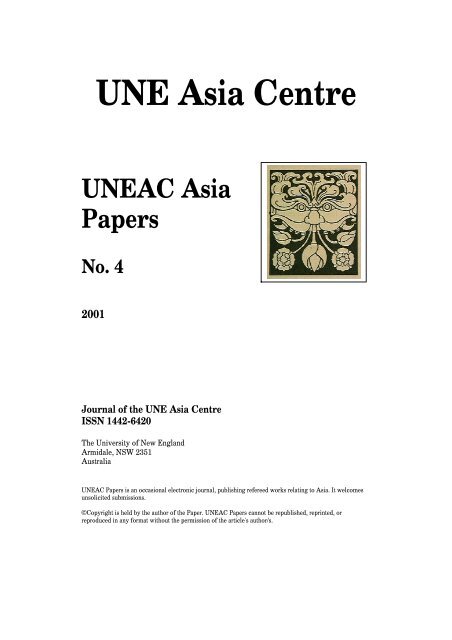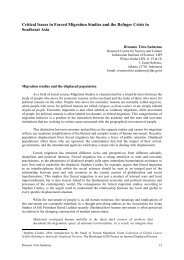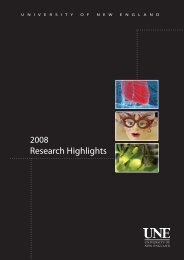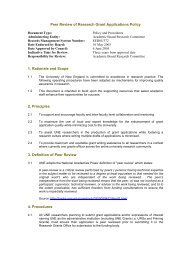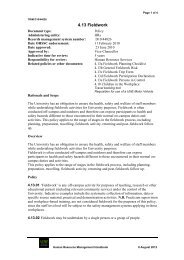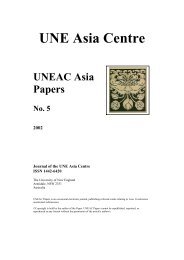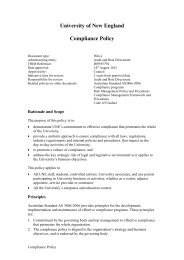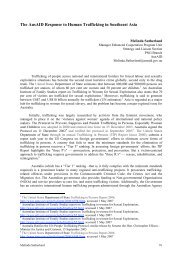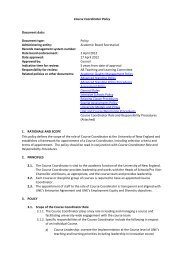Gender and Domesticity Liberalisation in Historical Perspective
Gender and Domesticity Liberalisation in Historical Perspective
Gender and Domesticity Liberalisation in Historical Perspective
Create successful ePaper yourself
Turn your PDF publications into a flip-book with our unique Google optimized e-Paper software.
UNE Asia Centre<br />
UNEAC Asia<br />
Papers<br />
No. 4<br />
2001<br />
Journal of the UNE Asia Centre<br />
ISSN 1442-6420<br />
The University of New Engl<strong>and</strong><br />
Armidale, NSW 2351<br />
Australia<br />
UNEAC Papers is an occasional electronic journal, publish<strong>in</strong>g refereed works relat<strong>in</strong>g to Asia. It welcomes<br />
unsolicited submissions.<br />
©Copyright is held by the author of the Paper. UNEAC Papers cannot be republished, repr<strong>in</strong>ted, or<br />
reproduced <strong>in</strong> any format without the permission of the article's author/s.
Editorial Board<br />
Associate Professor Howard Brasted, Director, Asia Centre<br />
Adjunct Professor Ian Metcalfe, Deputy Director, Asia Centre<br />
Professor Amarjit Kaur, Faculty of Economics, Bus<strong>in</strong>ess <strong>and</strong> Law<br />
Professor Acram Taji, Faculty of the Sciences<br />
Dr Paul Healy, Faculty of Arts<br />
Dr Narottam Bh<strong>in</strong>di, Faculty of Education, Health <strong>and</strong> Professional Studies<br />
Editors of this issue: Adjunct Professor Ian Metcalfe, Deputy Director, Asia<br />
Centre, <strong>and</strong> Associate Professor Howard Brasted, Director, Asia Centre.<br />
Editorial Adsvisory Board<br />
Professor Malcolm Falkus, University of New Engl<strong>and</strong><br />
Professor Robert Hall, University of London<br />
Professor Brian Stoddart, University of New Engl<strong>and</strong><br />
Professor Richard Robison, Murdoch University<br />
Professor Prakash Kumar, National University of S<strong>in</strong>gapore
CONTENTS<br />
No. 4, 2001<br />
Samita Sen <strong>Gender</strong> <strong>and</strong> <strong>Domesticity</strong> 1<br />
<strong>Liberalisation</strong> <strong>in</strong> <strong>Historical</strong><br />
<strong>Perspective</strong><br />
Kenneth E. Jackson Free Trade, Fair Trade: 21<br />
Trade <strong>Liberalisation</strong>, Environmental<br />
<strong>and</strong> Labour St<strong>and</strong>ards
<strong>Gender</strong> <strong>and</strong> <strong>Domesticity</strong><br />
<strong>Liberalisation</strong> <strong>in</strong> <strong>Historical</strong> <strong>Perspective</strong><br />
Samita Sen<br />
Department of History<br />
Calcutta University<br />
India<br />
In the early 1990s, the Government of India began to implement a fresh package of<br />
economic policies of the pattern put forward by the Bretton Woods authorities under<br />
the broad rubric of structural adjustment (henceforth SAP). Along side came new<br />
policies to reduce the state’s <strong>in</strong>terventionist <strong>and</strong> regulative role <strong>in</strong> the economy,<br />
which had been built up by previous governments as part of a ‘socialist’ rhetoric.<br />
Together the new economic policies were dubbed ‘liberalisation’ <strong>and</strong> were presumed to<br />
go h<strong>and</strong> <strong>in</strong> h<strong>and</strong> with broader processes of globalisation. For <strong>in</strong>dustry this entailed<br />
more emphasis on the ‘market’ <strong>in</strong> determ<strong>in</strong><strong>in</strong>g entry <strong>and</strong> exit <strong>and</strong> less protection<br />
aga<strong>in</strong>st foreign capital <strong>and</strong> the mult<strong>in</strong>ational corporations (MNCs). So far as labour is<br />
concerned, there has been no agreement about the precise nature of the impact these<br />
policies may have had or will have <strong>in</strong> the long term. A great deal has been said, rather<br />
nebulously <strong>in</strong> many cases, about the adverse effect of these policies on women <strong>in</strong><br />
particular. There is a grow<strong>in</strong>g apprehension that poorer women are the hardest hit by<br />
‘adjustments’. At a National Sem<strong>in</strong>ar on Policies <strong>and</strong> Strategies for Work<strong>in</strong>g Women<br />
<strong>in</strong> the Context of Industrial Restructur<strong>in</strong>g (New Delhi, 1997), Gita Sen emphasised<br />
that the new economic regime creates two simultaneous disadvantages for poor<br />
women. On the one h<strong>and</strong>, they face <strong>in</strong>creas<strong>in</strong>g pressures to earn from petty selfemployment,<br />
<strong>in</strong> the <strong>in</strong>formal sector <strong>and</strong> <strong>in</strong> production for larger <strong>in</strong>dustries. On the<br />
other h<strong>and</strong>, crumbl<strong>in</strong>g social security systems force women to be primary care-givers<br />
<strong>and</strong> responsible for the well-be<strong>in</strong>g of their communities. This co<strong>in</strong>cides with a<br />
regeneration of so-called ‘Asian’ values, which glorify women’s multiple roles as<br />
mothers, wives, contributors to the family economy <strong>and</strong> good citizens. ‘Globalisation’<br />
thus ‘dem<strong>and</strong>s “squar<strong>in</strong>g the circle” by mak<strong>in</strong>g women “choose” to work with<strong>in</strong> the<br />
home <strong>and</strong> <strong>in</strong> the <strong>in</strong>formal sector’. 1<br />
Other speakers at the sem<strong>in</strong>ar emphasised a different aspect of the liberalisation<br />
question. They argued that liberalisation had exacerbated exist<strong>in</strong>g negative trends <strong>in</strong><br />
the economy <strong>and</strong> that many of the so-called effects of SAP represented the outcomes<br />
of processes that were <strong>in</strong> place long before SAP was <strong>in</strong>itiated. 2 In a vast country like<br />
India with its complex <strong>and</strong> varied economy, a variety of consequences <strong>and</strong> responses<br />
are to be always expected. It should come as no surprise if, as <strong>in</strong> case of many other<br />
policies, the new economic policies do not affect ‘poor women’ uniformly. 3<br />
However, some broad generalisations <strong>and</strong> some trends <strong>in</strong> particular sectors are<br />
emerg<strong>in</strong>g. Economists are generally agreed that a tighter labour market has adversely<br />
affected the poor -- men, women <strong>and</strong> children alike. They also agree that<br />
liberalisation <strong>and</strong> <strong>in</strong>dustrial restructur<strong>in</strong>g will lead, <strong>in</strong>evitably, to an undercutt<strong>in</strong>g of<br />
organised labour. 4 So far, the tussle over ‘down-siz<strong>in</strong>g’ <strong>and</strong> job loss has been most<br />
manifest <strong>in</strong> central public sector units (CPSU) <strong>and</strong> is overloaded with assumptions of<br />
<strong>in</strong>efficiency, <strong>in</strong>dustrial sickness <strong>and</strong> cynicism towards a hitherto privileged section of<br />
workers. The CPSU situation has attracted greater public attention <strong>in</strong> part because<br />
their powerful unions have resisted retrenchment <strong>and</strong> won the support of opposition<br />
political parties. The CPSU workers have wrested, through union <strong>and</strong> political<br />
Samita Sen 1
pressure, major concessions such as the National Renewal Fund (1992). Though the<br />
NRF was meant for retra<strong>in</strong><strong>in</strong>g schemes as well, the largest part of its resources was<br />
utilised for pay<strong>in</strong>g compensation for voluntary retirement. While unions have had<br />
some success <strong>in</strong> cushion<strong>in</strong>g workers aga<strong>in</strong>st job loss <strong>in</strong> the CPSU, the larger federated<br />
unions are los<strong>in</strong>g ground with <strong>in</strong>creased retrenchment <strong>and</strong> mechanisation. Faced with a<br />
rapidly shr<strong>in</strong>k<strong>in</strong>g constituency, some of the traditional unions are beg<strong>in</strong>n<strong>in</strong>g to reorient<br />
their exclusionist strategy <strong>and</strong> to address hitherto ignored issues -- like that of<br />
women workers <strong>and</strong> workers <strong>in</strong> the <strong>in</strong>formal sector. There is, however, as yet little<br />
recognition ma<strong>in</strong>stream union policy of issues that the women’s movements have<br />
sought to place centre-stage. The chief of these issues is the need to question the<br />
division between personal/political <strong>and</strong> home/workplace, a necessary step <strong>in</strong><br />
underst<strong>and</strong><strong>in</strong>g the crisis <strong>in</strong> the organised sector. Without such underst<strong>and</strong><strong>in</strong>g, the<br />
present dilemma of traditional trade unionism is likely to deepen further. And this<br />
was clearly manifest <strong>in</strong> the late 1990s <strong>in</strong> the struggle <strong>in</strong> West Bengal vis a vis the<br />
federations of trade unions <strong>and</strong> the ‘reformist’ arm of the state government [led by<br />
the Communist Party of India (Marxist)].<br />
The shift <strong>in</strong> the state government’s attitude towards trade unions, even those<br />
affiliated to its own political parties, has been evident s<strong>in</strong>ce 1998 <strong>in</strong> a series of crises<br />
<strong>in</strong> the private sector as <strong>in</strong> Dunlop <strong>and</strong> Bata. Indeed, <strong>in</strong> most <strong>in</strong>dustrial centres of<br />
India, there have been large-scale job losses <strong>in</strong> the private sector. Without state<br />
support, these private sector workers have not been able to negotiate for the k<strong>in</strong>d of<br />
safety-net available to CPSU workers. Increase <strong>in</strong> the number of lock-outs began <strong>in</strong><br />
the 1980s <strong>and</strong> 1990s <strong>and</strong> many companies have run successful voluntary retirement<br />
schemes (VRS). In a study of the electronics <strong>in</strong>dustry, which employed a substantive<br />
proportion of women, Amrita Chhacchi shows how the swiftly chang<strong>in</strong>g patterns <strong>in</strong><br />
this <strong>in</strong>dustry led to large-scale forced <strong>and</strong> illegal retrenchment. She argues that the<br />
loss of better-paid <strong>and</strong> secure factory jobs impacted more on women s<strong>in</strong>ce they were<br />
less able to f<strong>in</strong>d alternative livelihood. Self-employment, <strong>in</strong> particular, rout<strong>in</strong>ely<br />
offered as the panacea for <strong>in</strong>dustrial restructur<strong>in</strong>g, is difficult for women even if they<br />
have skills <strong>and</strong>/or capital. 5 Socially held <strong>and</strong> <strong>in</strong>ternalised values of gender division of<br />
labour prevent women from sett<strong>in</strong>g up repair<strong>in</strong>g shops or driv<strong>in</strong>g auto-rickshaws<br />
which are men’s most preferred alternatives. 6<br />
Industrial retrenchment, however, impacts directly on very few women. The<br />
organised work force now st<strong>and</strong>s at less than 9 per cent of the total. Women are a<br />
negligible proportion of organised labour. The majority of women suffer the threats<br />
to organised <strong>in</strong>dustry <strong>in</strong>directly. This <strong>in</strong>direct impact is two-fold <strong>and</strong> <strong>in</strong> oppos<strong>in</strong>g<br />
directions. As members of male organised workers’ households, women are likely to<br />
be affected adversely by the losses of jobs, security <strong>and</strong>/or <strong>in</strong>come <strong>in</strong> that sector.<br />
Indeed some of them might be forced <strong>in</strong>to the labour market, which they perceive as<br />
a misfortune s<strong>in</strong>ce their work is likely to be <strong>in</strong> the <strong>in</strong>formal sector <strong>and</strong> thus poorly<br />
rewarded, not fully compensat<strong>in</strong>g for the loss <strong>in</strong> male earn<strong>in</strong>gs. Moreover, their<br />
‘go<strong>in</strong>g out to work’ <strong>in</strong>volves a loss of status; <strong>and</strong> undertak<strong>in</strong>g paid work cuts <strong>in</strong>to the<br />
reproductive work they earlier undertook towards improv<strong>in</strong>g the family’s st<strong>and</strong>ard of<br />
liv<strong>in</strong>g.<br />
The story of retrenchment <strong>and</strong> job loss needs to be qualified. While secure <strong>and</strong><br />
privileged workers, women <strong>and</strong> men, <strong>in</strong> the more traditional manufactur<strong>in</strong>g sector are<br />
under threat, <strong>in</strong> some new non-traditional export-oriented <strong>in</strong>dustries, women’s<br />
employment opportunities exp<strong>and</strong>ed s<strong>in</strong>ce the 1980s. These opportunities were<br />
availed by new categories of women, who were for the first time enter<strong>in</strong>g, <strong>in</strong> some<br />
significant numbers, the manufactur<strong>in</strong>g labour force. This seemed to be the case <strong>in</strong><br />
UNEAC Asia Papers No. 4 2
the ‘modern’ gem-cutt<strong>in</strong>g <strong>in</strong>dustry <strong>in</strong> Tamil Nadu. 7 Parents delayed marriage of<br />
daughters <strong>and</strong> accepted their employment even when it <strong>in</strong>volved long daily<br />
commut<strong>in</strong>g or long-distance migration. Though the phenomenon was limited, there<br />
was a creation of a labour pool of unmarried young women. These <strong>and</strong> other married<br />
women, it was feared, would undersell their labour <strong>and</strong> erode the barga<strong>in</strong><strong>in</strong>g advantages<br />
won by organised labour through over a century of struggle. It is believed that MNCs<br />
<strong>and</strong> export-oriented <strong>in</strong>dustries are committed to ‘flexible’ work<strong>in</strong>g <strong>and</strong> will<br />
automatically gravitate towards the least organised, most vulnerable <strong>and</strong> most flexible<br />
element <strong>in</strong> the labour market, the women.<br />
This paper discusses three issues raised by the above on-go<strong>in</strong>g debates. I will draw on<br />
my doctoral research on the jute <strong>in</strong>dustry <strong>in</strong> the colonial period to argue a case for<br />
treat<strong>in</strong>g these issues <strong>in</strong> a long-term historical perspective. The new economic policies<br />
did not start with a clean slate. They worked (<strong>and</strong> cont<strong>in</strong>ue to do so) <strong>in</strong> t<strong>and</strong>em with<br />
other social <strong>and</strong> economic trends some of which were <strong>in</strong>itiated long ago. It is<br />
difficult, often impossible, to isolate economic phenomenon that are exclusively<br />
related to SAP or liberalisation or any particular shift <strong>in</strong> policy. Quite possibly, there<br />
are areas <strong>in</strong> which there are no sharp breaks <strong>in</strong> the economic process or <strong>in</strong> the<br />
outlook of economic actors. It is always useful to take the long-term view because<br />
many critical developments began long before 1991 <strong>and</strong> appeared as established<br />
patterns or as ‘tradition’ encounter<strong>in</strong>g new change. It is plausible to argue, as some<br />
economists are do<strong>in</strong>g, that some trends set <strong>in</strong> motion already were aggravated to more<br />
significant levels by liberalisation. In this paper I will focus on certa<strong>in</strong> trends <strong>in</strong><br />
women’s work force participation which have shown long-term resilience <strong>and</strong> seem to<br />
be <strong>in</strong> danger of be<strong>in</strong>g aggravated by rather than radically altered by economic<br />
liberalisation or SAP. The first of these is the persistent <strong>and</strong> progressive exclusion of<br />
women from the organised sector, which reflects the general phenomenon of male<br />
monopoly over more reward<strong>in</strong>g occupations. The second related issue is the high<br />
degree of control exercised by the family over women’s labour. As a result, the<br />
family is able to deploy women's labour as a buffer aga<strong>in</strong>st changes <strong>in</strong> the economic<br />
situation. As male jobs become more reward<strong>in</strong>g <strong>and</strong> secure, women are withdrawn<br />
from economic activity as a signal of upward social mobility of the family. In periods<br />
of crisis, however, women’s labour can be <strong>in</strong>tensely exploited <strong>in</strong> the low wage<br />
<strong>in</strong>formal sector, particularly <strong>in</strong> home-based work, as a means of household survival.<br />
These issues have been discussed <strong>in</strong> relation to some of the debates outl<strong>in</strong>ed above <strong>and</strong><br />
draw<strong>in</strong>g on empirical evidence collected by a number of researchers <strong>in</strong> recent years.<br />
The paper will address, first, the much-discussed question of ‘fem<strong>in</strong>isation’ of the<br />
work force. It will be argued that term needs to be, <strong>in</strong> the Indian context, exam<strong>in</strong>ed<br />
<strong>in</strong> historical terms <strong>and</strong> aga<strong>in</strong>st firmly entrenched processes which ‘mascul<strong>in</strong>ised’<br />
organised labour. Second, the commonness of Senoconomics when applied to the case<br />
of women workers suggests that the effect of new economic policies will depend<br />
largely on the conditions of discrim<strong>in</strong>ation <strong>and</strong> deprivation from which they are<br />
forced to respond to these policies. It will be argued that, <strong>in</strong> the Indian context,<br />
women workers are a flexible resource, but for the household rather than for the<br />
employer. They relate to the labour market at a remove. Third, the significance of<br />
ideologies of domesticity <strong>in</strong> the determ<strong>in</strong>ation of ‘class’ status <strong>and</strong> respectability <strong>and</strong><br />
the non-negotiability of household work together create at times a ‘preference’<br />
among poor women for non-work<strong>in</strong>g housewife roles. Much of the recent evidence<br />
suggests, however, that otherwise poor women value their wage-earn<strong>in</strong>g role: young<br />
unmarried women <strong>in</strong> particular but also older married women.<br />
Samita Sen 3
The ‘Fem<strong>in</strong>isation’ thesis exam<strong>in</strong>ed<br />
The term ‘fem<strong>in</strong>isation’ <strong>in</strong> relation to the labour force has been used <strong>in</strong> two different<br />
ways. It can <strong>in</strong>dicate the employment of larger numbers of women so that the gender<br />
profile of the labour force, or a particular segment of it, actually changes <strong>in</strong> favour of<br />
women. It can <strong>in</strong>dicate, however, a very different process whereby the nature of jobs<br />
change. From more secure <strong>and</strong> regular employment, the economy shifts to k<strong>in</strong>ds of<br />
employment more associated with women, <strong>in</strong>formalised, casualised, irregular, lower<br />
paid <strong>and</strong> <strong>in</strong>secure. In the latter case, both women <strong>and</strong> men workers are forced <strong>in</strong>to<br />
this ‘fem<strong>in</strong>is<strong>in</strong>g’ pattern.<br />
The 1970s witnessed a clear case of the first phenomenon with the rise of the socalled<br />
New International Division of Labour. In the advanced <strong>in</strong>dustrialised countries<br />
of the west, technological advance made steady <strong>in</strong>roads <strong>in</strong>to male craft-skills <strong>and</strong><br />
allowed fragmentation of production processes. The ris<strong>in</strong>g transactional costs of<br />
labour <strong>in</strong> these countries led the MNCs to relocate their operations <strong>and</strong> to shift the<br />
labour-<strong>in</strong>tensive parts of production to ‘Third world’ countries. In the latter, women,<br />
especially young unmarried women, provided not only cheap labour, they also offered<br />
the crucial flexibility that mobile <strong>in</strong>ternational capital required to serve their volatile<br />
markets. Thus, <strong>in</strong> the seventies <strong>and</strong> eighties many East <strong>and</strong> South East Asian<br />
countries experienced a ‘fem<strong>in</strong>isation’ of factory work. Employers depended heavily<br />
on the ‘cheap’ <strong>and</strong> ‘docile’ labour of young unmarried women. This has also been the<br />
case <strong>in</strong> the Bangladesh garment <strong>in</strong>dustry. Women constitute some 60 per cent of the<br />
total work force (while they are 7 per cent of the non-export-oriented <strong>in</strong>dustries’<br />
labour force). Researchers argue that a perceived traditional fem<strong>in</strong><strong>in</strong>e skill <strong>in</strong> sew<strong>in</strong>g,<br />
cheapness, flexibility <strong>and</strong> docility are the reasons why garment <strong>in</strong>dustry employers<br />
have shown a strong preference for a predom<strong>in</strong>antly female work force. 8<br />
In many countries, SAP has resulted <strong>in</strong> women’s employment <strong>in</strong> the manufactur<strong>in</strong>g<br />
sector. What are the possibilities of such a ‘fem<strong>in</strong>isation’ of the <strong>in</strong>dustrial work force<br />
<strong>in</strong> India? There was some sectoral expansion <strong>in</strong> women’s employment <strong>in</strong> the<br />
seventies <strong>and</strong> eighties. First, there was a growth <strong>in</strong> non-agricultural employment<br />
(NAE) <strong>in</strong> the rural sector, crucial for rural development. Public sector spend<strong>in</strong>g <strong>in</strong><br />
rural areas, both through development programmes <strong>and</strong> through a spread effect from<br />
spend<strong>in</strong>g by employees of the rural public sector, resulted <strong>in</strong> a wide range of NAE.<br />
Economic liberalisation resulted <strong>in</strong> a significant cutback on rural public sector<br />
spend<strong>in</strong>g <strong>and</strong>, accord<strong>in</strong>g to Abhijit Sen, led to millions of jobs be<strong>in</strong>g lost. G.K. Chadha<br />
argues that the worst affected were low-<strong>in</strong>come rural women, many of whom have<br />
been pushed back <strong>in</strong>to low-paid casual agricultural work.<br />
These conclusions can be questioned on one count. The term NAE is an umbrella<br />
one, cover<strong>in</strong>g the smallest household based unit to the large formal sector <strong>in</strong>dustries.<br />
The <strong>in</strong>crease of workers <strong>in</strong> this exp<strong>and</strong>ed sector was more <strong>in</strong> the <strong>in</strong>formal <strong>and</strong><br />
unprotected end. It is not clear from which sectors with<strong>in</strong> NAE job losses were the<br />
heaviest. Chadha, however, argues that even the low-paid NAE tends -- <strong>in</strong>creas<strong>in</strong>gly -<br />
- to be significantly better paid than agricultural employment. Thus, women’s losses<br />
<strong>in</strong> the NAE <strong>and</strong> their return to casual agricultural work cannot but be detrimental.<br />
There was also some <strong>in</strong>crease <strong>in</strong> women’s employment <strong>in</strong> other sectors. Upto the<br />
eighties, the MNC had a restricted career <strong>in</strong> India: the emphasis on the diversification<br />
of economic activity, centralised plann<strong>in</strong>g <strong>and</strong> state control were <strong>in</strong>imical to the<br />
flexibilities desired by <strong>in</strong>ternational capital. But Nirmala Banerjee po<strong>in</strong>ts out that<br />
while India’s economy, under the leadership of a strong national bourgeoisie,<br />
UNEAC Asia Papers No. 4 4
ema<strong>in</strong>ed <strong>in</strong>wardly oriented <strong>and</strong> low <strong>in</strong> export earn<strong>in</strong>gs, there was a grow<strong>in</strong>g emphasis<br />
on export of non-traditional items like garments, leather, food products, toys <strong>and</strong><br />
jewellery. India’s labour laws compared well with advanced <strong>in</strong>dustrialised countries <strong>and</strong><br />
the political power of organised labour was strong. But the ma<strong>in</strong> workers <strong>in</strong> the new<br />
sectors were unorganised, often piece-rated female labour <strong>in</strong> sweat-shops or <strong>in</strong> homebased<br />
work. In addition, the 1970s <strong>and</strong> 80s also witnessed an <strong>in</strong>crease <strong>in</strong> women’s<br />
employment <strong>in</strong> non home-based manufactur<strong>in</strong>g. 9 (Table 1 below)<br />
What effect did the new economic policies have on this k<strong>in</strong>d of employment? In a<br />
few select <strong>in</strong>dustries like gem <strong>and</strong> jewellery, women were employed <strong>in</strong> lower paid <strong>and</strong><br />
unskilled tasks s<strong>in</strong>ce technological developments allowed reduction of skilled male<br />
workers. In the electronics <strong>in</strong>dustry, which is highly mobile, there appears to be job<br />
rotation between men <strong>and</strong> women. Generally speak<strong>in</strong>g, the n<strong>in</strong>eties saw a halt<strong>in</strong>g of<br />
the process of expansion of women’s employment. This was partly an effect of a<br />
general slow-down but there were also some cases of substitution of women by men<br />
workers. In the plastics <strong>in</strong>dustry, trade unions <strong>in</strong> large <strong>and</strong> medium scale units signed<br />
an agreement with the management negotiat<strong>in</strong>g the fixation of tasks <strong>and</strong><br />
designations. This has ensured that women are restricted to jobs <strong>in</strong> assembl<strong>in</strong>g <strong>and</strong><br />
pack<strong>in</strong>g. As a result, they were removed from the mach<strong>in</strong>es they were operat<strong>in</strong>g. 10<br />
Sujata Ghotosker shows how the expansion of women’s employment <strong>in</strong><br />
pharmaceutical companies (like Glaxo) was reversed when they decided to ‘put out’<br />
some of their production to smaller scale units. These latter preferred to employ<br />
men. 11<br />
No one dom<strong>in</strong>ant trend emerges from the different case studies, though the tendency<br />
seems to be more towards loss rather than ga<strong>in</strong> <strong>in</strong> women’s employment. Accord<strong>in</strong>g<br />
to Nirmala Banerjee, there was not only no overall <strong>in</strong>crease <strong>in</strong> women’s employment<br />
<strong>in</strong> the manufactur<strong>in</strong>g sector, but a sharp fall <strong>in</strong> the period immediately follow<strong>in</strong>g the<br />
<strong>in</strong>itiation of new economic policies both <strong>in</strong> rural <strong>and</strong> urban areas. Only <strong>in</strong> the urban<br />
tertiary sector have there been some discernible <strong>in</strong>crease. She argues that there has<br />
been no radical change <strong>in</strong> the behaviour of the Indian economy after SAP, the major<br />
parameters affect<strong>in</strong>g women workers have rema<strong>in</strong>ed steady between 1981 <strong>and</strong> 1996.<br />
Earlier trends have been aggravated, however, lead<strong>in</strong>g to further deterioration <strong>in</strong><br />
women’s economic position. 12<br />
If we consider the urban manufactur<strong>in</strong>g sector alone, there seems to have been an<br />
overall <strong>in</strong>crease <strong>in</strong> women’s employment <strong>in</strong> the decade of the 1990s. There was a<br />
small decl<strong>in</strong>e immediately after the <strong>in</strong>troduction of SAP to be followed by an absolute<br />
<strong>and</strong> proportionate <strong>in</strong>crease <strong>in</strong> women’s employment <strong>in</strong> the private sector (the public<br />
sector rema<strong>in</strong><strong>in</strong>g more or less constant).<br />
Notably, there have always been some women, <strong>and</strong> <strong>in</strong> different <strong>in</strong>dustries at different<br />
po<strong>in</strong>ts <strong>in</strong> time, who do not fit the stereotype of low-paid, irregular, casual workers.<br />
The stereotype is true for the majority of women, but <strong>in</strong> some <strong>in</strong>dustries, unionisation<br />
<strong>and</strong> workers’ struggles have won better wages <strong>and</strong> security for women workers as well<br />
as the men. It is also important to note that the l<strong>in</strong>k between higher wages <strong>and</strong> job<br />
security no longer holds <strong>in</strong> all cases. Some women have found jobs <strong>in</strong> large units<br />
where employers <strong>in</strong>vest <strong>in</strong> tra<strong>in</strong><strong>in</strong>g <strong>and</strong> proffer higher wages <strong>and</strong> <strong>in</strong>centives but do not<br />
offer security. It is the more lucrative <strong>and</strong>/or secure jobs from which women are<br />
pushed out <strong>in</strong> periods of change or crisis. Such was the case <strong>in</strong> many <strong>in</strong>dustries across<br />
India (textiles <strong>and</strong> m<strong>in</strong><strong>in</strong>g) <strong>in</strong> the 1920s <strong>and</strong> 30s, <strong>in</strong> the 1950s <strong>and</strong> 60s <strong>and</strong> is once<br />
aga<strong>in</strong> the case <strong>in</strong> the 1990s. It is women workers from this privileged section who<br />
Samita Sen 5
have lost their jobs as a result of restructur<strong>in</strong>g to become either unemployed or move<br />
<strong>in</strong>to the <strong>in</strong>formal sector.<br />
Table 1<br />
Employment of Women <strong>in</strong> the Organised Sector<br />
(household <strong>and</strong> non-household manufactur<strong>in</strong>g <strong>and</strong> m<strong>in</strong><strong>in</strong>g <strong>and</strong> quarry<strong>in</strong>g only)<br />
Public sector<br />
Private sector<br />
Total<br />
(thous<strong>and</strong>s)<br />
Women<br />
(thous<strong>and</strong>s)<br />
Percentage<br />
of women<br />
Total<br />
(thous<strong>and</strong>s)<br />
Women<br />
(thous<strong>and</strong>s)<br />
percentage<br />
of women<br />
1971 988 36 3.6 4359 429 9.8<br />
1981 2320 154 6.6 4675 163 3.4<br />
1991 2851 174 6.1 4580 527 11.5<br />
1995 2772 190 6.8 4809 501 10.4<br />
1997 2639 168 6.3 5331 874 16.3<br />
1998 2553 164 6.4 5324 942 17.6<br />
Source: Manpower Profile. India Yearbook 2000, Institute of Applied Manpower research, New<br />
Delhi, 2000. Table 3.2.22 <strong>and</strong> 3.2.24 (pp. 334-339)<br />
While men tend to monopolise the better paid jobs, when employment is tighter,<br />
they tend to take over the jobs women previously undertook, push<strong>in</strong>g the latter lower<br />
down the scale to even less desirable jobs. Neither the NIDL of the 1970s, nor the<br />
NEP of 1990s have had any transformative effect on this gender pattern of the<br />
labour market. Rather, a supposed stubborn ‘tradition’ or ‘culture’ of exclusion of<br />
women from the wage labour is rout<strong>in</strong>ely trotted out to ‘expla<strong>in</strong>’ the exceptional<br />
male dom<strong>in</strong>ance of <strong>in</strong>dustrial work. Given the universality <strong>and</strong> the low age of<br />
marriage (which barely approaches the statutory m<strong>in</strong>imum of 18), there is no<br />
equivalent ‘pool’ of young unmarried women who have been the providers of labour<br />
<strong>in</strong> the South East Asian countries. There has been no large-scale <strong>in</strong>duction of women<br />
<strong>in</strong> factory <strong>in</strong>dustry, either under national or MNC auspices.<br />
On the contrary, there has always been a clear preference for men <strong>in</strong> modern factory<br />
<strong>in</strong>dustry <strong>and</strong> as this sector tended to be more ‘formalised’ by state regulation <strong>and</strong><br />
work<strong>in</strong>g conditions improved through ‘organisation’ of labour, they tended to exclude<br />
women more. Beg<strong>in</strong>n<strong>in</strong>g <strong>in</strong> the 1920s <strong>and</strong> 30s <strong>and</strong> until the 90s, the ‘traditional’<br />
manufactur<strong>in</strong>g sector has cont<strong>in</strong>ued to elim<strong>in</strong>ate women from their work force. 13<br />
From a study I undertook <strong>in</strong> July 1997 compar<strong>in</strong>g a rayon mill <strong>and</strong> a jute mill, it<br />
appears that while an older ‘crisis-ridden’ <strong>in</strong>dustry could undertake this elim<strong>in</strong>ation<br />
relatively gradually, a more dynamic rayon mill, which had benefited significantly<br />
from liberalisation, was more hostile to employ<strong>in</strong>g women. 14<br />
Let us look at the case of the jute <strong>in</strong>dustry <strong>in</strong> more detail. The first jute mill was set<br />
up <strong>in</strong> 1855 <strong>in</strong> Hooghly near Calcutta. The <strong>in</strong>dustry took off <strong>in</strong> the 1870s <strong>and</strong> grew<br />
rapidly <strong>in</strong> the next few decades, it cont<strong>in</strong>ued to be enormously profitable until it hit<br />
its first crisis <strong>in</strong> 1930s, recovered dur<strong>in</strong>g the Second World War <strong>and</strong> then went <strong>in</strong>to<br />
decl<strong>in</strong>e <strong>in</strong> the late 1960s <strong>and</strong> early 1970s. S<strong>in</strong>ce then it has been limp<strong>in</strong>g along, with<br />
periodic spurts of activity, protected by the state, often even subsidised by the state<br />
government. It is a labour-<strong>in</strong>tensive <strong>in</strong>dustry employ<strong>in</strong>g very large numbers of<br />
workers <strong>and</strong> is localised <strong>in</strong> the suburban fr<strong>in</strong>ge of the city of Calcutta. In the 1950s,<br />
the workers numbered over 3 million. The political importance of this concentrated<br />
UNEAC Asia Papers No. 4 6
labour force has been understood clearly by the state, the management of the mills<br />
<strong>and</strong> various political parties from the very beg<strong>in</strong>n<strong>in</strong>g. Of this vast <strong>and</strong> significant<br />
workforce, the highest recorded proportion of women was about 20 per cent (towards<br />
the close of the n<strong>in</strong>eteenth century). By the 1940s women constituted about 12-3 per<br />
cent of the work force. By the 1970s, they were reduced to a negligible 2 per cent<br />
<strong>and</strong> this has decl<strong>in</strong>ed further <strong>in</strong> the 1990s. This decl<strong>in</strong>e has been part of a general<br />
trend <strong>in</strong> India -- <strong>in</strong> coal <strong>in</strong>dustry women started to lose their share of jobs when they<br />
were banned from underground work <strong>in</strong> 1928. In plantations, they reta<strong>in</strong>ed their<br />
share (about half to start with) a little longer because of the perceived ‘fem<strong>in</strong><strong>in</strong>e’ skill<br />
<strong>in</strong>volved <strong>in</strong> low-paid pluck<strong>in</strong>g jobs. In the cotton textile <strong>in</strong>dustry, <strong>in</strong> Bombay <strong>and</strong><br />
Ahmedabad, women’s numbers <strong>and</strong> proportions decl<strong>in</strong>ed from the 1930s. In all these<br />
<strong>in</strong>dustries, while labour became more heterogeneous <strong>in</strong> terms of caste, community <strong>and</strong><br />
region, it also became discernibly more male. 15 The number of women <strong>in</strong> Indian<br />
<strong>in</strong>dustry almost halved between 1911 <strong>and</strong> 1971.<br />
Table 2<br />
Women <strong>in</strong> Industry<br />
Number of women employed<br />
(<strong>in</strong> thous<strong>and</strong>s)<br />
Percentage of total female<br />
labour<br />
1911 6137 14.7<br />
1921 5409 13.5<br />
1931 5147 13.7<br />
1951 4554 11.2<br />
1961 6884 11.6<br />
1971 3307 10.5<br />
Source: Towards Equality. Report of the Committee on Status of Women, 1974, p. 153<br />
There was a clear decl<strong>in</strong><strong>in</strong>g trend <strong>in</strong> the case of factories <strong>and</strong> m<strong>in</strong>es.<br />
Table 3<br />
Percentage of Women (of total workers) <strong>in</strong> Factories <strong>and</strong> M<strong>in</strong>es<br />
FACTORIES<br />
MINES<br />
1951 11.43 20.1<br />
1961 10.65 15.8<br />
1971 9.1 11.9<br />
Source: Towards Equality. Report of the Committee on Status of Women, 1974, p. 187<br />
The manner of women’s exclusion from factory <strong>in</strong>dustry begs a host of questions<br />
about the material <strong>and</strong> social reproduction of labour as well as entrepreneurial<br />
strategy. Industrial employers had, from the beg<strong>in</strong>n<strong>in</strong>g, prioritised flexibility of<br />
labour. While labour <strong>in</strong> the formal sector became <strong>in</strong>creas<strong>in</strong>gly <strong>in</strong>flexible from the<br />
1950s, state regulation or trade unions failed to cover the majority of workers.<br />
Researchers argue that <strong>in</strong> the 1990s, moreover, there was a ‘blurr<strong>in</strong>g of the traditional<br />
dist<strong>in</strong>ctions between formal/<strong>in</strong>formal <strong>and</strong> organised/unorganised sectors’. Apart from<br />
Samita Sen 7
the two poles of permanent-secure workers <strong>and</strong> destitute workers, there arose (<strong>and</strong><br />
rema<strong>in</strong>s) a wide range <strong>and</strong> variety of work status. 16 In fact this has always been the<br />
case, even <strong>in</strong> the core organised sector. To achieve flexibility, employers exerted<br />
enormous pressure to casualise a large part of their labour. It has been always difficult<br />
to susta<strong>in</strong> (especially for the period before 1930s) any dist<strong>in</strong>ction between ‘organised’<br />
<strong>and</strong> ‘unorganised’ labour either <strong>in</strong> terms of their condition of employment or <strong>in</strong> terms<br />
of their collective barga<strong>in</strong><strong>in</strong>g power. Even now, <strong>in</strong>dividual workers move between<br />
various sectors of the labour market <strong>and</strong> members of households are employed <strong>in</strong><br />
widely vary<strong>in</strong>g k<strong>in</strong>ds of economic activities. A strongly segmented ‘dual’ labour<br />
market never quite obta<strong>in</strong>ed, argues R.S. Ch<strong>and</strong>avarkar. 17<br />
The jute <strong>in</strong>dustry’s history is one of constant tussle between management <strong>and</strong> labour<br />
over issues of casualisation. Industrial employers were more concerned with<br />
flexiibility than with long-term labour settlement. They employed men who migrated<br />
for a period of their work<strong>in</strong>g lives from the neighbour<strong>in</strong>g regions of Bengal. These<br />
employers could depend upon <strong>in</strong>cessant migration to replenish this male workforce.<br />
Operat<strong>in</strong>g <strong>in</strong> a highly surplus labour market they could pass on the costs of social,<br />
physical <strong>and</strong> skill reproduction of the work force to the workers themselves. The<br />
<strong>in</strong>dustry had no need of <strong>in</strong>dividualised or proletarianised workers. Rather, s<strong>in</strong>gle male<br />
migrants, who had a buffer <strong>in</strong> their ‘rural tie’ were best able to provide the casual<br />
labour the <strong>in</strong>dustry desired. Men, <strong>in</strong> particular, were both available <strong>and</strong> preferred. It<br />
were the men who had control over migration decisions <strong>in</strong> the household. Male heads<br />
of household were able to reta<strong>in</strong> flexibility <strong>in</strong> the urban <strong>and</strong> <strong>in</strong>dustrial labour market<br />
by comm<strong>and</strong><strong>in</strong>g more <strong>in</strong>tensive work from women for lower allocation of resources.<br />
The legal <strong>and</strong> adm<strong>in</strong>istrative apparatus of the colonial state aided this process by<br />
strengthen<strong>in</strong>g the position of the paterfamilias <strong>and</strong> <strong>in</strong>creas<strong>in</strong>g the male head of the<br />
family’s control over women <strong>and</strong> children. As a result, women’s migration operated<br />
with<strong>in</strong> several constra<strong>in</strong>ts. They left their villages when rural resources were<br />
completely exhausted -- accompany<strong>in</strong>g their families <strong>in</strong> times of acute scarcities or<br />
leav<strong>in</strong>g their families when they were denied (adequate) access to household resources<br />
because of widowhood, barrenness or unchastity. Such women were less prone to<br />
periodically visit the village ‘home’ as male migrants rout<strong>in</strong>ely did. Certa<strong>in</strong>ly, most<br />
women migrants had less rural or household resources to fall back on by way of<br />
<strong>in</strong>surance. The men, by contrast, returned to the village <strong>in</strong> case of sickness,<br />
unemployment or at retirement. They were able to do so because the women <strong>and</strong><br />
children (<strong>and</strong> some elder men) cont<strong>in</strong>ued to procure subsistence from village<br />
resources. Thus, among the migrants, the women (rather than men) were more likely<br />
to be ‘proletarianised’ <strong>in</strong> the conventional sense -- <strong>and</strong> this constituted a disadvantage<br />
<strong>in</strong> the <strong>in</strong>secure urban labour market. Thus, gender played a constitutive role <strong>in</strong> the<br />
mak<strong>in</strong>g of the jute work<strong>in</strong>g class. 18<br />
A sudden acceleration of ‘s<strong>in</strong>gle’ male migrants from Bihar, Orissa <strong>and</strong> Andhra<br />
Pradesh at the turn of the century began the process of women’s marg<strong>in</strong>alisation <strong>in</strong><br />
the jute <strong>in</strong>dustry. Their relatively ‘unskilled’ jobs were taken over by migrant men.<br />
Women, more than before, were clustered at the lower end of the mill as cheap male<br />
labour became available for mach<strong>in</strong>e-h<strong>and</strong>l<strong>in</strong>g jobs. 19 From the early 1900s to 1930,<br />
the proportion of women <strong>in</strong> the work force rema<strong>in</strong>ed fairly steady at about 15 per<br />
cent. The first significant retrenchment came <strong>in</strong> the 1930s. Enormously high war<br />
profits (1914-1919) had encouraged a massive rush of <strong>in</strong>vestment. The <strong>in</strong>dustry<br />
faced the Depression with tremendously over-extended production capacity. The<br />
Indian Jute Mills’ Association could not unite all the mills <strong>in</strong> their attempt to w<strong>in</strong><br />
government support for all-<strong>in</strong>dustry strategies to keep prices from crash<strong>in</strong>g. Instead<br />
the government <strong>in</strong>sisted upon rationalisation, efficiency <strong>and</strong> streaml<strong>in</strong><strong>in</strong>g. The<br />
UNEAC Asia Papers No. 4 8
government asked for st<strong>and</strong>ardisation of wage rates, employment <strong>and</strong> work<strong>in</strong>g<br />
conditions. A great deal of heat was generated by these negotiations, but labour<br />
efficiency rema<strong>in</strong>ed a secondary concern. The mills embarked on a susta<strong>in</strong>ed<br />
reduction of labour costs through piecemeal mechanisation, retrenchments, wage cuts<br />
<strong>and</strong> overload<strong>in</strong>g.<br />
Such ‘rationalisation’ did not affect the work force uniformly. Mechanisation, for<br />
<strong>in</strong>stance, hurt women workers more. The practice of employ<strong>in</strong>g women <strong>in</strong> the less<br />
mechanised sections of the mill had become entrenched by 1930. The <strong>in</strong>troduction<br />
of mach<strong>in</strong>ery <strong>in</strong> these processes usually entailed retrenchment of the women <strong>and</strong> the<br />
employment of fewer men <strong>in</strong> their place. By long habit, the assumption that women<br />
could not h<strong>and</strong>le mach<strong>in</strong>ery had become a conviction. At a time when the economy<br />
was shr<strong>in</strong>k<strong>in</strong>g, male workers <strong>and</strong> trade unions were more than happy to encourage this<br />
myth. 20 In Bombay, however, when mechanisation came to the ‘women’s<br />
departments’ <strong>in</strong> the 1920s, women workers put up stiff resistance aga<strong>in</strong>st<br />
retrenchment with support from trade unions. 21 In the jute <strong>in</strong>dustry, there is little<br />
evidence of such collective resistance aga<strong>in</strong>st women’s retrenchment.<br />
Similar attacks on women’s jobs became more pronounced <strong>in</strong> a new round of<br />
‘rationalisation’ undertaken <strong>in</strong> the 1950s. Employers offered various arguments as to<br />
why women were to be gradually elim<strong>in</strong>ated: they could not be employed on night<br />
shifts, they had to be paid maternity benefit <strong>and</strong> provide crèche facility. Trade<br />
unions, faced with spirall<strong>in</strong>g male unemployment, were more than will<strong>in</strong>g to<br />
encourage these arguments. S<strong>in</strong>ce direct retrenchment had become difficult, early<br />
retirement <strong>and</strong> ‘natural wastage’ were used to replace women by men. Women could<br />
be persuaded or coerced to give up their jobs to a son. 22 Women workers found it<br />
difficult to resist the comb<strong>in</strong>ed onslaught of the family, the unions <strong>and</strong> the employers.<br />
A survey of National Jute Mill <strong>in</strong> the 1970s found 2.6 per cent women <strong>in</strong> a work<br />
force of 16,386. In almost all the cases, women worked because there were no adult<br />
males to ‘take over’ their jobs <strong>and</strong> almost half of these workers were casually<br />
employed. 23<br />
In the 1990s, after two decades of uncerta<strong>in</strong>ty <strong>in</strong> the <strong>in</strong>dustry <strong>and</strong> periodic crises <strong>in</strong><br />
<strong>in</strong>dividual mills, jute mill jobs are no longer as secure. Nevertheless, <strong>in</strong> comparison to<br />
the ‘<strong>in</strong>formal’ sector, mill employment rema<strong>in</strong>s lucrative. As before, the most<br />
coveted are the small number of ‘permanent’ jobs but there are also a whole range of<br />
not-so-permanent jobs which are graded accord<strong>in</strong>g to security of employment,<br />
number of days of work available <strong>and</strong> social security entitlements. The permanent<br />
workers are also the best represented by the unions <strong>and</strong> tend to follow narrowly<br />
exclusionist strategies. For <strong>in</strong>stance, unions <strong>and</strong> management agree to reserve job<br />
‘nom<strong>in</strong>ations’ to male heirs. Only when such male heirs are not forthcom<strong>in</strong>g, do<br />
female heirs qualify. In new recruitment, as <strong>in</strong> case of the ‘zero record’ or ‘voucher’<br />
workers (the most casualised section of the work force), women are not enterta<strong>in</strong>ed at<br />
all. Women tend to cluster <strong>in</strong> the middle b<strong>and</strong> of ‘badli’ workers. And their numbers<br />
(as well as proportions) have decl<strong>in</strong>ed further s<strong>in</strong>ce 1970s. 24<br />
Women workers, households <strong>and</strong> employers<br />
It is often argued that women are more adversely affected by economic liberalisation<br />
because they bear the brunt of the household’s poverty. The argument relates to the<br />
second underst<strong>and</strong><strong>in</strong>g of the ‘fem<strong>in</strong>isation’ thesis outl<strong>in</strong>ed <strong>in</strong> the earlier section. The<br />
assault on the organised sector, the undercutt<strong>in</strong>g of organised labour <strong>and</strong> the political<br />
weaken<strong>in</strong>g of trade unions will, together, it is feared, lead to a general squeeze on poor<br />
Samita Sen 9
households. As more male workers are shunted <strong>in</strong>to low paid jobs, household <strong>in</strong>comes<br />
will decl<strong>in</strong>e, more women will be forced <strong>in</strong>to poorly paid work <strong>in</strong> the <strong>in</strong>formal sector<br />
<strong>and</strong> total family welfare will decl<strong>in</strong>e. Women will suffer more because when there is<br />
less to go round, their share of household resources decl<strong>in</strong>es more steeply. 25<br />
Why is it that women suffer more when there is less to go around? Because they do<br />
already. Women will suffer more: they always do so; besides, not only will they suffer<br />
more than they do now, but also, presumably, more than men will suffer. Such circular<br />
logic is underp<strong>in</strong>ned by exist<strong>in</strong>g, persistent <strong>and</strong> long-term patterns of gender disparity<br />
<strong>and</strong> discrim<strong>in</strong>ation <strong>in</strong> the labour market <strong>and</strong> the household which get <strong>in</strong>scribed <strong>in</strong>to<br />
economic change. Economic actors, like the state <strong>and</strong> its agents, the employers <strong>and</strong><br />
their agents, workers (male <strong>and</strong> female) <strong>and</strong> trade unions operate <strong>in</strong> this play<strong>in</strong>g field<br />
which is far from level.<br />
From a survey of garment <strong>in</strong>dustries <strong>in</strong> Delhi, garment <strong>and</strong> electronic <strong>in</strong>dustries <strong>in</strong> the<br />
Thane-Pune region of Maharashtra, the Coimbatore textile <strong>in</strong>dustry <strong>and</strong> five small<br />
<strong>in</strong>dustries (garment, leather, prawn process<strong>in</strong>g, silk sp<strong>in</strong>n<strong>in</strong>g <strong>and</strong> reel<strong>in</strong>g) <strong>in</strong> Bengal,<br />
Banerjee offers a profile of the woman worker <strong>in</strong> the 1970s. Most of the women<br />
were casual workers work<strong>in</strong>g, typically, with low capital <strong>in</strong>vestment <strong>in</strong> tools <strong>and</strong><br />
technology. There was lower familial <strong>in</strong>vestment <strong>in</strong> their education, health <strong>and</strong><br />
nutrition. Most women workers were married, burdened with exclusive responsibility<br />
for housework <strong>and</strong> child care. 26<br />
The labour market shows two clear gender characteristics. First, women rarely take<br />
over men’s jobs by undercutt<strong>in</strong>g them. Men, too, despite high unemployment, do not<br />
usually undercut women. The terms of competition <strong>in</strong> this labour market are<br />
somewhat differently determ<strong>in</strong>ed. The gender composition of a work force is<br />
primarily subject to male decision-mak<strong>in</strong>g. Male workers exert control over women’s<br />
labour through familial relationships (wife/daughter) <strong>and</strong> acquire flexibility (usually<br />
associated with women) for jobs that are lucrative <strong>and</strong> where such flexibility is desired.<br />
(This was the case <strong>in</strong> the jute <strong>in</strong>dustry).<br />
Employers cannot use women workers to undercut overly dem<strong>and</strong><strong>in</strong>g male labour by<br />
direct replacement. Also, men resist ‘women’s jobs’ unless they are significantly<br />
redef<strong>in</strong>ed or relocated. The most common situation <strong>in</strong> which this happens is when<br />
mach<strong>in</strong>ery is <strong>in</strong>troduced for a previously manual job. In periods of crisis, however, or<br />
if the terms of the jobs improve, men do lay claim to women’s jobs. Both these<br />
tendencies were evident <strong>in</strong> the jute <strong>in</strong>dustry <strong>in</strong> different periods. To undercut male<br />
workers with female or child labour, however, employers have to undertake jobdifferentiation<br />
(usually <strong>in</strong>clud<strong>in</strong>g wage cuts <strong>and</strong> casualisation) or even major<br />
reorganisation of production (usually <strong>in</strong>volv<strong>in</strong>g a shift from factory/workshop to<br />
home-based). This latter was the case <strong>in</strong> the biri-roll<strong>in</strong>g <strong>in</strong>dustry. Thus, women do<br />
undercut men, but usually not at their own <strong>in</strong>stance <strong>and</strong> not without considerable<br />
entrepreneurial <strong>in</strong>itiative. There has to be an evident ‘preference’ on part of<br />
employers for them to adopt such strategies.<br />
Over the years, there has been a marked tendency for men to move out of<br />
unremunerative traditional household activities like weav<strong>in</strong>g. In West Bengal <strong>in</strong> the<br />
1990s, for example, the family cont<strong>in</strong>ues to be <strong>in</strong>volved <strong>in</strong> h<strong>and</strong>loom weav<strong>in</strong>g by<br />
deploy<strong>in</strong>g women’s ‘spare time’. The earlier taboo aga<strong>in</strong>st women’s work<strong>in</strong>g at the<br />
loom has broken down <strong>and</strong> women now weave at home while the men jo<strong>in</strong> the new<br />
powerloom factories as wage workers. The men moreover cont<strong>in</strong>ue to h<strong>and</strong>le the<br />
‘bus<strong>in</strong>ess’ end of the household <strong>in</strong>dustry -- procur<strong>in</strong>g orders <strong>and</strong> market<strong>in</strong>g f<strong>in</strong>ished<br />
UNEAC Asia Papers No. 4 10
goods. As a result, women have no control over the earn<strong>in</strong>gs from this productive<br />
labour they undertake <strong>in</strong> addition to housework <strong>and</strong> their traditional task of yarnprocess<strong>in</strong>g.<br />
The goods they produce are usually of poor quality s<strong>in</strong>ce they have been<br />
given no opportunity to acquire the necessary skill or knowledge. 27<br />
Given these patterns, it is difficult to try <strong>and</strong> predict the impact of state policies on<br />
women’s employment. Casualisation is not new <strong>in</strong> India <strong>and</strong> was never specific to<br />
women. The st<strong>and</strong>ard conventions of large-scale <strong>in</strong>dustry, except for a brief fiftyyears<br />
period, have never been ‘rational’ <strong>in</strong> the Indian context <strong>and</strong> is break<strong>in</strong>g down<br />
elsewhere as well. Employers preference for casualised male labour often co<strong>in</strong>cides<br />
with male claims on ‘women’s jobs’, especially <strong>in</strong> periods of high unemployment.<br />
These tendencies have contributed to a long term, often drastic, exclusion of women<br />
from more reward<strong>in</strong>g occupations like factory jobs. Periodic exceptions are more due<br />
to supply bottlenecks than to chang<strong>in</strong>g entrepreneurial preference. It may <strong>in</strong> fact be<br />
argued that neither national nor MNC employment strategies are likely to make any<br />
significant dent <strong>in</strong> the labour market <strong>in</strong> this regard. Indeed, as mentioned earlier, the<br />
new spurt <strong>in</strong> export <strong>in</strong>dustries <strong>in</strong> the 1990s did not lead (as <strong>in</strong> the 1970s) to expansion<br />
<strong>in</strong> women’s employment. In the case of Glaxo as cited above, desire for ‘flexibility’<br />
<strong>in</strong> the 1990s led not to augmentation of the female work force they had employed <strong>in</strong><br />
the 1970s but to fragmentation of production <strong>and</strong> putt<strong>in</strong>g out to smaller enterprises.<br />
The new employers have tended to prefer men workers who are more amenable to<br />
flexible work<strong>in</strong>g.<br />
Clearly then, women are not universally more flexible labour. To the Indian<br />
employer, they are less. The ‘fem<strong>in</strong>isation’ of factory labour <strong>in</strong> South East Asia has<br />
depended on young unmarried women. In India, women usually jo<strong>in</strong> the labour force<br />
after marriage when they already have children. These women are constra<strong>in</strong>ed by<br />
their family roles as wives <strong>and</strong> mothers. They are less mobile <strong>and</strong> unable to commit<br />
longer hours to paid work. This is the largest <strong>and</strong> most vulnerable section of the<br />
female work force, hampered by lack of education, mobility, opportunity to acquire<br />
or upgrade skills or f<strong>in</strong>d alternate livelihood. They are most liable to be pushed <strong>in</strong>to<br />
work<strong>in</strong>g more <strong>in</strong>tensively as unpaid family labour or as cheap labour for uncerta<strong>in</strong><br />
work. They do not offer the advantages that the factory girl <strong>in</strong> Thail<strong>and</strong> or Taiwan<br />
does to employers. The married Indian women workers are less flexible than men.<br />
Rather, the men acquire greater flexibility by abjur<strong>in</strong>g housework <strong>and</strong> childcare<br />
responsibilities, <strong>and</strong> also by controll<strong>in</strong>g women’s <strong>and</strong> children’ wage labour decisions.<br />
So women <strong>and</strong> children often enter <strong>and</strong> exit the labour market <strong>in</strong> response to the male<br />
breadw<strong>in</strong>ner’s employment situation. They enter the market when it is shr<strong>in</strong>k<strong>in</strong>g <strong>and</strong><br />
terms for labour are unfavourable -- male earn<strong>in</strong>gs become more <strong>in</strong>constant,<br />
<strong>in</strong>adequate or suspended. They withdraw when the employment situation beg<strong>in</strong>s to<br />
improve <strong>and</strong> the men are able to ‘w<strong>in</strong> the bread’. Thus women are flexible workers --<br />
but more for the family than for the employer. The family’s particular requirements<br />
place limits on their flexibility <strong>in</strong> the labour market.<br />
The issue of labour flexibility needs to be rethought. Flexibility may operate at the<br />
level of organisational structure, <strong>in</strong> the pattern of production <strong>and</strong>/or <strong>in</strong> the labour<br />
market. At each of these levels, the dynamics <strong>and</strong> <strong>in</strong>dicators of flexibility are<br />
different. It has been po<strong>in</strong>ted out that the Indian labour market has always been<br />
flexible <strong>in</strong> some ways. In fact, flexible labour is a s<strong>in</strong>e qua non for large-scale<br />
<strong>in</strong>dustries. For all <strong>in</strong>dustries, a certa<strong>in</strong> degree of flexibility is required <strong>and</strong> a great deal<br />
of flexibility is desired. While workers struggle to set m<strong>in</strong>imum non-negotiable<br />
st<strong>and</strong>ards of work<strong>in</strong>g, employers drive for as much flexibility as possible <strong>in</strong> any given<br />
situation. There is a drive towards a new (or nascent) flexibility, which requires<br />
Samita Sen 11
<strong>in</strong>dividual workers to have access to skills <strong>and</strong> retra<strong>in</strong><strong>in</strong>g. Employers are exert<strong>in</strong>g<br />
<strong>in</strong>creas<strong>in</strong>g pressure to be able to move workers across job boundaries. There is also<br />
<strong>in</strong>creas<strong>in</strong>g emphasis on older forms of flexibility such as the manipulation of labour<br />
time <strong>and</strong> costs. The fixed costs of full time <strong>and</strong> permanent workers militate aga<strong>in</strong>st<br />
such calculations. The management of large-scale units seek to achieve flexibility <strong>in</strong><br />
such situations by creat<strong>in</strong>g obscure job descriptions <strong>and</strong> hop<strong>in</strong>g to divide workers by<br />
<strong>in</strong>troduc<strong>in</strong>g a wide variety of employment types <strong>and</strong> conditions. Thus they seek to<br />
grade <strong>and</strong> hierarchise agents of flexibility. And here too gender is a key element.<br />
There are at least three crucial ways <strong>in</strong> which women are at a disadvantage where both<br />
the newer <strong>and</strong> older forms of flexibility comm<strong>and</strong> a premium.<br />
First, the non-negotiability of housework as women’s responsibility limits the time<br />
they can spend at work. An important part of their work life beg<strong>in</strong>s after they return<br />
from their workplace. My 1997 survey reveals that there has been almost no change<br />
<strong>in</strong> the pattern of housework distribution. When women get help with housework, it is<br />
from other women members of the household or at best a teenage son. Adult men,<br />
even if unemployed will not help with housework. As a result, women cannot work<br />
very long hours or get the benefit of lucrative 'overtime' work. Rather, they prefer to<br />
limit the amount of physical stra<strong>in</strong> at the workplace. 28 Also, they have to take more<br />
leave <strong>and</strong> holidays because they tend to allocate themselves lower quantity <strong>and</strong> quality<br />
of food <strong>and</strong> are, therefore, more prone to illness 29 <strong>and</strong>/or because they are responsible<br />
for the sick <strong>and</strong> old <strong>in</strong> the family. It is the most vulnerable women -- unmarried,<br />
deserted, divorced or widowed -- who offer flexibility from sheer compulsion. In one<br />
study it has been found that married women put <strong>in</strong> long hour of overtime only when it<br />
is compulsory. 30<br />
Second, tra<strong>in</strong><strong>in</strong>g <strong>and</strong> gender l<strong>in</strong>k the workplace <strong>and</strong> the labour market with household<br />
hierarchy. On the one h<strong>and</strong>, young girls <strong>and</strong> women are denied scope <strong>and</strong> access to<br />
education <strong>and</strong> tra<strong>in</strong><strong>in</strong>g by the family, long before they enter the labour market; on the<br />
other, mach<strong>in</strong>es <strong>and</strong> workplaces are gendered too. A sexual division of labour is<br />
embedded <strong>in</strong> each social <strong>and</strong> technical division of labour. Thus men <strong>and</strong> women tend<br />
to participate <strong>in</strong> different spaces, shops or sections of the factory when they usually<br />
operate or set up different ‘physical technologies’ that require skills or knowledge<br />
also def<strong>in</strong>ed as male or female. This is justified by the argument of ‘natural’<br />
complementariety of their roles but is usually accompanied by a ‘vertical sexual<br />
division of labour’ -- account<strong>in</strong>g for discrim<strong>in</strong>atory wage gaps, patterns of promotion<br />
<strong>and</strong> supervisory functions. 31<br />
Third, the dom<strong>in</strong>ance of personalised <strong>and</strong> <strong>in</strong>formal channels of recruitment allows<br />
male workers to <strong>in</strong>fluence the gender composition of the work force. S<strong>in</strong>ce <strong>in</strong>ception,<br />
large-scale <strong>in</strong>dustry has depended on recruitment through myriad social networks<br />
based on k<strong>in</strong>, caste <strong>and</strong> regional affiliations. Such a ‘system’ became staple by the end<br />
of the n<strong>in</strong>eteenth century. Over time the ‘<strong>in</strong>formal’ channels have been<br />
<strong>in</strong>stitutionalised. 32 Given the slow growth rate of organised sector <strong>and</strong> the tight<br />
labour market, recruitment is fairly sluggish. There is almost no direct recruitment<br />
now. Recruitment takes place either through union channels or by nom<strong>in</strong>ation. If a<br />
worker dies while <strong>in</strong> service, his 'heirs' replace him. A retir<strong>in</strong>g worker has the 'right' to<br />
‘nom<strong>in</strong>ate’ a successor. Also, sometimes, he may auction the ‘nom<strong>in</strong>ation’ to nonk<strong>in</strong><br />
c<strong>and</strong>idates. In attempt<strong>in</strong>g to prevent such practices, management <strong>and</strong> unions<br />
have agreed to restrict nom<strong>in</strong>ation to a ‘son’ or a ‘son-<strong>in</strong>-law’, re-entrench<strong>in</strong>g the<br />
‘family’ <strong>in</strong> recruitment <strong>and</strong> clos<strong>in</strong>g off women’s access to jobs by nom<strong>in</strong>ation. S<strong>in</strong>ce<br />
nom<strong>in</strong>ation was the only channel through which many ‘widows’ had earlier entered<br />
factory jobs, such policies are greatly resented by women. It appears that as factory<br />
UNEAC Asia Papers No. 4 12
jobs become ‘property’, women’s <strong>in</strong>heritance disabilities <strong>in</strong> the larger social field are<br />
echoed <strong>in</strong> their access to factory employment. 33<br />
There are many fall-outs of these gender characteristics <strong>in</strong>scribed <strong>in</strong> the workplace<br />
<strong>and</strong> the labour market. Male supervisors’ notions of what k<strong>in</strong>d of work is appropriate<br />
for women <strong>in</strong>fluence the pattern of their employment. Male values of segregation <strong>and</strong><br />
male workers’ <strong>in</strong>terest <strong>in</strong> reta<strong>in</strong><strong>in</strong>g control <strong>and</strong> use of women’s sexuality <strong>and</strong> labour<br />
are written <strong>in</strong>to hir<strong>in</strong>g practices. Moreover, the supervisors <strong>and</strong> other clerical staff<br />
can extract sexual favours from women <strong>in</strong> return for access to jobs which <strong>in</strong>creases<br />
the opprobrium of factory work for women <strong>and</strong> ensures their withdrawal from such<br />
jobs when higher male earn<strong>in</strong>gs allow them to do so. Often, women move from<br />
highly paid factory work to most ill-paid home-based work. On the basis of a study of<br />
beedi-workers’ attempts at organisation <strong>in</strong> Hyderabad, Roh<strong>in</strong>i Hensman argues that<br />
husb<strong>and</strong>s <strong>and</strong> employers have a common <strong>in</strong>terest <strong>in</strong> keep<strong>in</strong>g women conf<strong>in</strong>ed <strong>in</strong> the<br />
house while at the same time earn<strong>in</strong>g an <strong>in</strong>come. And husb<strong>and</strong>s have the social<br />
sanction to use violence to enforce their wishes. 34<br />
The better-paid male workers use the recruitment system to effectively exclude<br />
women from the more prized jobs (with<strong>in</strong> the factory or from the factory<br />
altogether). Possibly they fear that women’s <strong>in</strong>duction will threaten their ability to<br />
ma<strong>in</strong>ta<strong>in</strong> high wage levels. But why do some of them not use their personal <strong>and</strong><br />
family channels to recruit their own mothers, wives, daughters or sisters <strong>in</strong> high<br />
pay<strong>in</strong>g jobs thereby augment<strong>in</strong>g their household resources? Obviously, the few who<br />
might desire better <strong>in</strong>comes for their women relatives are unable to contravene<br />
established rules of gender segregation. So, the more lucrative jobs go to male<br />
protégés while wives <strong>and</strong> daughters may be given the lower paid jobs where women<br />
tend to cluster. In part this also reflects a preference for male rather than female<br />
earners <strong>in</strong> the family. The better-paid workers are better able to ma<strong>in</strong>ta<strong>in</strong> nonearn<strong>in</strong>g<br />
adult female relatives, <strong>and</strong> often do so. To have wives liv<strong>in</strong>g <strong>in</strong> various<br />
modified forms of seclusion <strong>and</strong> domesticity <strong>in</strong> the city signals higher social status.<br />
Such practices further ghettoise women at the lower rungs of the job ladder. S<strong>in</strong>ce<br />
their ‘own’ women do not work, the better paid <strong>and</strong> more <strong>in</strong>fluential workers (often<br />
also active union activists) have no obvious <strong>in</strong>terest <strong>in</strong> promot<strong>in</strong>g women for better<br />
jobs.<br />
Thus, male decision-mak<strong>in</strong>g <strong>in</strong> the family <strong>and</strong> the workplace impact on women’s job<br />
decisions. In the situation of a tight labour market, competition among workers may<br />
run along gender l<strong>in</strong>es too. Roh<strong>in</strong>i Hensman Banaji found such <strong>in</strong>stances when<br />
<strong>in</strong>terview<strong>in</strong>g workers at Hoechst:<br />
Dissident worker: In contrast to the women, who are gett<strong>in</strong>g very good pay <strong>in</strong>clud<strong>in</strong>g<br />
a lot of overtime, <strong>and</strong> who don’t need it so much s<strong>in</strong>ce they are married to husb<strong>and</strong>s<br />
who are also earn<strong>in</strong>g well, they [young men] feel that they themselves are suffer<strong>in</strong>g<br />
due to the D.A. ceil<strong>in</strong>g.<br />
Interviewer: Is there discrim<strong>in</strong>ation aga<strong>in</strong>st men <strong>in</strong> the allocation of overtime?<br />
Dissident worker: No...<br />
Interviewer: And do you th<strong>in</strong>k women should get less pay than men because they have<br />
husb<strong>and</strong>s who are earn<strong>in</strong>g as well? If they get the same pay, does that mean there is<br />
discrim<strong>in</strong>ation aga<strong>in</strong>st the men?<br />
Samita Sen 13
Dissident worker: No. But there is a difference between the objective situation <strong>and</strong><br />
the way it is seen, <strong>and</strong> these young [men] workers feel they are be<strong>in</strong>g discrim<strong>in</strong>ated<br />
aga<strong>in</strong>st.<br />
Older leaders felt, on the contrary, that:<br />
In compar<strong>in</strong>g their pay with that of much more senior women employees, they [the<br />
young men] ignore the fact that by the time they reach the same level of seniority<br />
their own pay will be very much higher.... One of them [young men workers] used<br />
threats of assault aga<strong>in</strong>st a woman worker to get her to reduce production, <strong>and</strong> got<br />
himself suspended.’ 35<br />
Dependence <strong>and</strong> autonomy [ 36]<br />
Discussions on women’s work have often two levels of concern: first, the obvious <strong>and</strong><br />
immediate questions of livelihood <strong>and</strong> survival <strong>in</strong> the case of the poor; <strong>and</strong> second,<br />
more broadly, an engagement with the Engelsian question of the autonomy women<br />
may (or may not) derive from access to waged work. This paper has shown the<br />
question of women’s employment <strong>and</strong>, therefore, any question of women’s autonomy<br />
must address the family, which is the critical site for the construction of female<br />
dependence. Hilary St<strong>and</strong><strong>in</strong>g concludes from her study of women workers <strong>in</strong> Calcutta,<br />
The mean<strong>in</strong>g of employment for women must be sought <strong>in</strong> the context of the<br />
ways <strong>in</strong> which women’s lives are bounded by the family.... The family is the<br />
critical site <strong>in</strong> the construction of female dependency. The ways <strong>in</strong> which this<br />
dependency is structured have implications, first for which women enter the<br />
labour market <strong>and</strong> which are withdrawn from it at particular historical moments,<br />
<strong>and</strong> second, for women’s capacity to secure their short- <strong>and</strong> long-term material<br />
circumstances. Structures of dependency are related to, but do not reflect<br />
mechanically, the chang<strong>in</strong>g dem<strong>and</strong>s for female labour, or class position. The<br />
family is an arena of <strong>in</strong>tense ideological mediation <strong>and</strong> women’s access to paid<br />
work is constra<strong>in</strong>ed by historically <strong>and</strong> culturally specific concepts of familial<br />
dependency <strong>and</strong> what are considered appropriate behaviours <strong>and</strong> occupation for<br />
women. 37<br />
In her analysis, there are four structures of familial dependency:<br />
(a) economic, imply<strong>in</strong>g f<strong>in</strong>ancial dependence on male k<strong>in</strong>;<br />
(b) legal, through regulation impos<strong>in</strong>g gender-asymmetrical marriage, domicile <strong>and</strong><br />
<strong>in</strong>heritance;<br />
(c) ideologies of domesticity which constitute women as dependants <strong>and</strong> men as<br />
‘breadw<strong>in</strong>ners’; <strong>and</strong><br />
(d) psychic <strong>and</strong> social construction of fem<strong>in</strong><strong>in</strong>e identity which subjects women to<br />
male (sometimes older female) authority figures. 38<br />
Access to employment may challenge some of these, rarely all of these. More<br />
importantly, the terms on which the access is ga<strong>in</strong>ed, <strong>and</strong> the ability to cont<strong>in</strong>ue to<br />
ma<strong>in</strong>ta<strong>in</strong> this access is very often determ<strong>in</strong>ed by these structures themselves. Thus,<br />
the k<strong>in</strong>d of women who work <strong>and</strong> the k<strong>in</strong>d of work they do are very often cont<strong>in</strong>gent<br />
on male decision-mak<strong>in</strong>g <strong>in</strong> the family, euphemised as ‘family decision-mak<strong>in</strong>g’ or<br />
‘household strategy’ for livelihood or survival.<br />
Importantly, patriarchal construction of female dependence is not uniform. Rather,<br />
‘class’ (previously ‘caste’) differences are based on differential constructions of<br />
fem<strong>in</strong><strong>in</strong>ity. Multiple patriarchies constitute women of different caste/class status <strong>in</strong><br />
UNEAC Asia Papers No. 4 14
different ways, which bear erratic <strong>and</strong> quasi-functional relations to each other. The<br />
visibility of lower caste/class women -- <strong>in</strong> workplaces <strong>and</strong> streets -- denigrate their<br />
men. The economic <strong>and</strong> sexual exploitation of lower caste/class women marks out<br />
the upper caste/class men’s ability to ensure the security of their own women. Men<br />
of subord<strong>in</strong>ate castes <strong>and</strong> classes struggle, <strong>in</strong> turn, to reverse the conspicuous denial to<br />
them of exclusive access to <strong>and</strong> control over their women’s sexuality <strong>and</strong> labour<br />
power. 39 Thus upward caste/class mobility gets easily fixated on visible <strong>and</strong> ensurable<br />
symbols of familial control over women: withdrawal from paid work; dowry <strong>and</strong><br />
arranged early marriages; deployment <strong>in</strong> status-rais<strong>in</strong>g housework.<br />
So far as the women themselves are concerned, there are varied <strong>and</strong> sometimes<br />
contradictory responses. Poor women are less able to stretch the given norms of<br />
fem<strong>in</strong><strong>in</strong>e identity than urban middle class women. And they f<strong>in</strong>d themselves trapped<br />
between their underst<strong>and</strong><strong>in</strong>g of discrim<strong>in</strong>ation <strong>and</strong> their aspirations for higher socioeconomic<br />
status. In female workers’ own tell<strong>in</strong>g, they realise the actual similarity <strong>in</strong><br />
the content of male <strong>and</strong> female work <strong>and</strong> po<strong>in</strong>t out that these are obscured by<br />
constructions of skill. Equally, they themselves often echo managerial <strong>and</strong> union<br />
dist<strong>in</strong>ctions of male <strong>and</strong> female tasks, especially on the grounds of physical strength<br />
<strong>and</strong> stra<strong>in</strong>. These dist<strong>in</strong>ctions are sometimes <strong>in</strong>tegral to the expression of fem<strong>in</strong><strong>in</strong>e<br />
identity. Given the hard manual labour that is rout<strong>in</strong>e to their lives, a public statement<br />
of physical weakness is a means of claim<strong>in</strong>g fem<strong>in</strong><strong>in</strong>e frailty. They also accept the<br />
management’s arguments about protective legislation be<strong>in</strong>g the ma<strong>in</strong> reason for<br />
deny<strong>in</strong>g women jobs <strong>in</strong> the organised sector -- these constitute a public recognition of<br />
say, motherhood <strong>and</strong> sexual protection. But this is usually accompanied by an<br />
underst<strong>and</strong><strong>in</strong>g that ‘protection’ applies to better paid jobs. Women are forced <strong>in</strong>to<br />
small-scale <strong>and</strong> <strong>in</strong>formal jobs where conditions may be similar (or usually worse) <strong>and</strong><br />
where no protection applies. The women also tacitly accept that for most men, the<br />
job is a crucial source of identity <strong>and</strong> of public recognition of their capability. In their<br />
own cases, familial roles are more def<strong>in</strong><strong>in</strong>g, publicly <strong>and</strong> privately. Women <strong>in</strong><br />
<strong>in</strong>secure <strong>and</strong> heavy work <strong>in</strong> the <strong>in</strong>formal sector also share the primacy of familial<br />
identities, but they often have no choice but to submerge these <strong>in</strong> the face of the<br />
dem<strong>and</strong>s of employers at great cost to their family lives, their health <strong>and</strong> their leisure<br />
time. The double shift looms very large <strong>in</strong> women workers’ day-to-day experience of<br />
work. They recognise <strong>and</strong> accept the non-negotiability of domestic work <strong>and</strong> its<br />
responsibilities (the primary def<strong>in</strong><strong>in</strong>g feature of their fem<strong>in</strong><strong>in</strong>e identity) <strong>and</strong> are,<br />
therefore, more ambiguous about their role as workers <strong>and</strong> commitment to the<br />
workplace. 40<br />
The ideology of domestic fem<strong>in</strong><strong>in</strong>ity has a special attraction for poor women. Paid<br />
work is usually monotonous, always physically dem<strong>and</strong><strong>in</strong>g <strong>and</strong> carries the danger of<br />
sexual harassment. They are thus more susceptible to be<strong>in</strong>g pushed further <strong>in</strong>to the<br />
family but simultaneously always vulnerable to be<strong>in</strong>g pulled out of it <strong>and</strong> <strong>in</strong>to paid<br />
work dur<strong>in</strong>g household exigencies. Paradoxically, this trend is re<strong>in</strong>forced by the<br />
difference <strong>in</strong> the earn<strong>in</strong>g potential between husb<strong>and</strong> <strong>and</strong> wife, but also results <strong>in</strong><br />
further<strong>in</strong>g this difference by direct<strong>in</strong>g women towards even lower paid home-based<br />
work. The 1970s survey of a jute mill found that an overwhelm<strong>in</strong>g majority of<br />
women (all from lower castes) believed factory work to be unsuitable for women.<br />
They would prefer ‘home-based self-employment’ draw<strong>in</strong>g on traditional skills like<br />
sew<strong>in</strong>g despite the lower earn<strong>in</strong>gs. This response did not vary by level of household<br />
<strong>in</strong>come. 41 Such gender differentiated employment choices are reflected <strong>in</strong> the<br />
structure of employment.<br />
Samita Sen 15
Table 4<br />
<strong>Gender</strong> distribution of total urban employment by status of employment<br />
(1972-1998)<br />
M A L E<br />
F E M A L E<br />
Selfemployed<br />
Regular Casual TOTAL Self-employed Regular Casual TOTAL<br />
1972- 39.2 50.7 10.1 100 48.4 27.9 23.7 100<br />
73<br />
1977- 40.4 46.4 13.2 100 49.5 24.9 25.6 100<br />
78<br />
1983 40.9 43.7 15.4 100 45.8 25.8 28.4 100<br />
1987- 41.7 43.7 14.6 100 47.1 27.5 25.4 100<br />
88<br />
1990- 40.7 44.2 15.1 100 49.0 25.9 25.1 100<br />
91<br />
1993- 41.7 42.0 16.3 100 45.8 28.4 25.8 100<br />
94<br />
1997 40.0 41.5 18.5 100 39.7 31.3 29.0 100<br />
1998 42.5 39.5 18.1 100 38.4 32.7 28.9 100<br />
Source: Manpower Profile. India Yearbook 2000, Institute of Applied Manpower research, New<br />
Delhi, 2000. Table 3.2.7, p. 307<br />
We see that while men tend to be <strong>in</strong> self or regular employment, women tend to<br />
concentrate <strong>in</strong> self-employment. Unlike men, women workers are equally distributed<br />
between regular <strong>and</strong> casual employment. Moreover, while men’s self-employment<br />
shows a slight <strong>in</strong>creas<strong>in</strong>g trend, women’s show a rather steeper decl<strong>in</strong>e.<br />
The 1970s jute mill survey showed that few women aspire to <strong>in</strong>duct their daughter or<br />
daughter-<strong>in</strong>-law <strong>in</strong>to regular factory employment. Rather, marriage to a man who<br />
could afford to keep them out of the mills was more desirable. In the organised<br />
sector, the withdrawal of women from ‘outside’ work became evident from the 1930s<br />
<strong>and</strong> 1940s. With yet more improvement <strong>in</strong> wages <strong>and</strong> work<strong>in</strong>g conditions s<strong>in</strong>ce the<br />
1970s, factory workers aspired to upward social mobility -- education for their sons<br />
<strong>and</strong> dowry marriages for (non-productive) daughters. The withdrawal of the wife<br />
from paid labour outside the house was usually the first step <strong>in</strong> such a progression.<br />
These confirmations of the domestic ideal created more difficulties for women who<br />
did work <strong>in</strong> factories. In many jute mills, patterns of women’s employment have held<br />
over a century. In 1891, Taroni told the Factory Commission that women who<br />
worked <strong>in</strong> the mills were all widows <strong>and</strong> that only widows <strong>in</strong> unfortunate circumstances<br />
worked <strong>in</strong> factories. 42 Throughout the 1920s <strong>and</strong> 30s observers commented on the<br />
predom<strong>in</strong>ance of ‘s<strong>in</strong>gle’ women <strong>in</strong> jute mills. 43 In 1970 <strong>in</strong> the National Jute Mill,<br />
more than half the women workers were the sole earners <strong>in</strong> their family. The other<br />
half had been ‘forced’ <strong>in</strong>to mill employment by the husb<strong>and</strong>’s loss of employment. 44<br />
In Well<strong>in</strong>gton jute mill <strong>in</strong> 1997, women workers were almost entirely composed of<br />
widows <strong>and</strong> deserted women. 45<br />
It is not surpris<strong>in</strong>g that women workers do not consider mill work ‘suitable’ for<br />
women <strong>and</strong> endorse the role of the ‘housewife’ as most desirable for their daughters,<br />
even though the price of such desired marriages often cripple poor families. In the<br />
1940s, K.P. Chattopadhyay noted <strong>in</strong> a survey steep <strong>in</strong>creases <strong>in</strong> dowry dem<strong>and</strong>s<br />
among the urban poor. 46 It is now so obvious as to render ‘survey’ irrelevant.<br />
UNEAC Asia Papers No. 4 16
And yet, these attitudes were not universal then. 47 In the 1990s, there has been more<br />
change. Older women who had worked <strong>in</strong> the mills many years were not happy to<br />
rel<strong>in</strong>quish their jobs <strong>and</strong> were not so particular about daughters <strong>and</strong> daughters-<strong>in</strong>-law<br />
abjur<strong>in</strong>g factory work. However, they acquiesced with ‘family’ decisions to ma<strong>in</strong>ta<strong>in</strong><br />
non-work<strong>in</strong>g young adult women ascrib<strong>in</strong>g such decisions to the men <strong>in</strong> the family.<br />
Some women were more positive, question<strong>in</strong>g managerial <strong>and</strong> employment policy of<br />
exclud<strong>in</strong>g women. In the case of the rayon mill, women had a more uniformly<br />
positive approach to factory work. However, their desire for factory work was<br />
limited to the areas <strong>and</strong> tasks with<strong>in</strong> which they were limited by managerial <strong>and</strong> union<br />
decision-mak<strong>in</strong>g. 48<br />
The experience of female garment workers <strong>in</strong> Bangladesh po<strong>in</strong>t <strong>in</strong> a completely<br />
different direction. An active preference for docile workers has resulted <strong>in</strong> a<br />
predom<strong>in</strong>antly female work force. But such women have not complied with<br />
managerial expectancy of docility. Their active <strong>in</strong>volvement with unions has led to a<br />
decrease <strong>in</strong> women’s employment <strong>in</strong> the <strong>in</strong>dustry. Managers argue that the cost of<br />
women’s employment rises when issues of maternity leave <strong>and</strong> absenteeism are taken<br />
<strong>in</strong>to account. Predictably, employers prefer unmarried or s<strong>in</strong>gle women who<br />
constitute over 60 per cent of the work force (whereas they are about forty per cent<br />
<strong>in</strong> the total female work force). Despite lack of security, considerable gender<br />
discrim<strong>in</strong>ation <strong>in</strong> wages, long hours <strong>and</strong> deplorable work conditions, women have a<br />
positive attitude to wage employment <strong>in</strong> the <strong>in</strong>dustry. They have benefited, not only<br />
<strong>in</strong> <strong>in</strong>tangibles like autonomy, self-confidence, improved conjugal lives, matrimonial<br />
relationship but also <strong>in</strong> decreased fertility, <strong>in</strong>creased age of marriage <strong>and</strong> reduction <strong>in</strong><br />
dowry dem<strong>and</strong>s. While wider societal attitudes rema<strong>in</strong> negative towards these<br />
women’s ‘public’ activity, they themselves have developed a positive self-image. 49<br />
One of the surpris<strong>in</strong>g f<strong>in</strong>d<strong>in</strong>gs of a recent survey is that 35 per cent of the sample<br />
were women who had left their husb<strong>and</strong>s <strong>in</strong> the village to search for jobs <strong>in</strong> garment<br />
factories. 50<br />
Amrita Chhacchi’s survey of retrenched workers <strong>in</strong> the electronics <strong>in</strong>dustry <strong>in</strong> Delhi<br />
focuses attention on how much the women value their status <strong>and</strong> identity as skilled<br />
workers. Some of these women resisted enter<strong>in</strong>g the unorganised sector, others found<br />
their entry barred either by family decision or wider social norms. Most of them,<br />
however, felt the loss of physical mobility <strong>and</strong> economic <strong>in</strong>dependence acutely. Many<br />
of the younger women, married <strong>and</strong> unmarried, were forced by economic pressures to<br />
undertake low paid or home-based jobs which they saw as demean<strong>in</strong>g. 51 In the<br />
electronics <strong>in</strong>dustry <strong>in</strong> Delhi as well as <strong>in</strong> the Bombay pharmaceutical <strong>in</strong>dustries,<br />
unions derived considerable strength from the presence of large numbers of militant<br />
women. 52<br />
Conclusion<br />
In some cases thus wage employment has led women towards some forms of<br />
‘autonomy’: self-confidence, assertiveness <strong>and</strong> new values of self-worth. In the<br />
Indian scenario, however, most work<strong>in</strong>g women are already wife <strong>and</strong> mother <strong>and</strong><br />
familial dependency cont<strong>in</strong>ues to mediate their access to <strong>and</strong> experience of wage<br />
work. As a result, <strong>in</strong> certa<strong>in</strong> historical circumstances, the improvement <strong>in</strong> male<br />
work<strong>in</strong>g conditions (as <strong>in</strong> organised <strong>in</strong>dustry) has promoted <strong>and</strong> fostered poor<br />
women’s withdrawal <strong>in</strong>to domestic roles which have been the primary means through<br />
which they seek opportunities of self-improvement <strong>and</strong> status-rais<strong>in</strong>g.<br />
Samita Sen 17
The new economic policies are likely to undercut these ‘domestic’ aspirations of the<br />
women of hitherto more secure <strong>and</strong> upwardly mobile work<strong>in</strong>g classes. Women’s own<br />
access to such employment has always been very restricted <strong>and</strong> is likely to be more<br />
elusive. At the same time, other groups of women are be<strong>in</strong>g able to access<br />
employment before marriage. Poorer women’s access to such employment emerged<br />
significantly <strong>in</strong> the 1970s. Such jobs may now be under some threat, though we see<br />
that <strong>in</strong> the 1990s when the proportion of men <strong>in</strong> regular jobs is decreas<strong>in</strong>g, the<br />
proportion of women <strong>in</strong> the same category is <strong>in</strong>creas<strong>in</strong>g. (Table 4) It is necessary, of<br />
course, to look more carefully <strong>in</strong>to the k<strong>in</strong>d of regular jobs <strong>in</strong>to which women are<br />
enter<strong>in</strong>g. For a vast majority of poor women, employment is concentrated <strong>in</strong> the<br />
most vulnerable <strong>and</strong> <strong>in</strong>secure sectors. A majority of women cont<strong>in</strong>ue to respond to<br />
‘family’ imperatives as to when <strong>and</strong> where they work. It is likely that the recent<br />
changes <strong>in</strong> the labour market will re<strong>in</strong>force rather than erode the pervasive value of<br />
dependence, which cont<strong>in</strong>ues to <strong>in</strong>here <strong>in</strong> def<strong>in</strong>itions of Indian fem<strong>in</strong><strong>in</strong>ity.<br />
Endnotes<br />
[1<br />
2<br />
3<br />
4<br />
5<br />
6<br />
7<br />
8<br />
9<br />
10<br />
A Report, National Sem<strong>in</strong>ar on Policies <strong>and</strong> Strategies for Work<strong>in</strong>g Women <strong>in</strong><br />
the Context of Industrial Restructur<strong>in</strong>g, (22-25 September 1997), The<br />
Institute of Social Studies (The Hague) <strong>and</strong> Front for Rapid Economic<br />
Advancement (Mumbai, India). Quotation from p. 2<br />
Ibid., p. 13-14.<br />
Sachetana, A Report. Structural Adjustment Programmes. Impact on<br />
Women’s Work, mimeo, Calcutta, October 1997, Introductory Section.<br />
There is a grow<strong>in</strong>g literature on this subject. ILO-ARTEP, Social Dimensions<br />
of Structural Adjustment <strong>in</strong> India, Papers <strong>and</strong> proceed<strong>in</strong>gs of a tripartite<br />
workshop, New Delhi, December 10-11, 1991; G. Parthasarathy,<br />
‘Unorganised Sector <strong>and</strong> Structural Adjustment, EPW, 13 July 1996, XXXI,<br />
28, pp. 1859-1869; Supriya Roy Chowdhury, ‘Industrial Restructur<strong>in</strong>g, Unions<br />
<strong>and</strong> the State, Textile Mill workers <strong>in</strong> Ahmedabad, EPW, 24 February 1996,<br />
XXXI, 8; B.B. Patel, ‘Informalisation of Indian Labour. Displaced Textile<br />
Mill Workers <strong>in</strong> Gujarat <strong>and</strong> their Struggle for Alternatives’, paper submitted<br />
to ‘The World of Indian Industrial Labour’, Amsterdam, 10-13 December<br />
1997.<br />
Amrita Chhacchi, ‘The Experience of Job Loss <strong>in</strong> the Electronics Industry’,<br />
Paper presented at the workshop on ‘The World of Indian Industrial Labour’,<br />
Amsterdam, 10-13 December 1997.<br />
Nirmala Banerjee, ‘Someth<strong>in</strong>g old, someth<strong>in</strong>g new, someth<strong>in</strong>g borrowed...The<br />
Electronics <strong>in</strong>dustry <strong>in</strong> Calcutta <strong>in</strong> S. Mitter, <strong>and</strong> S. Rowbotham (eds) Women<br />
Encounter Technology: Chang<strong>in</strong>g Patterns of Employment <strong>in</strong> the Third<br />
World, UNU-INTECH, Routledge, London, 1995.<br />
Kar<strong>in</strong> Kapadia,<br />
See for <strong>in</strong>stance, Debapriya Bhattacharya, Women <strong>and</strong> Industrial<br />
Employment <strong>in</strong> Bangladesh: Challenges <strong>and</strong> Opportunities <strong>in</strong> the Era of New<br />
Technologies, A Research Report, Bangladesh Institute of Development<br />
Studies, 1997; <strong>and</strong> Debapriya Bhattacharya <strong>and</strong> Mustafizur Rahaman, Female<br />
Employment under Export-propelled Industrialisation: Prospect for<br />
Internalis<strong>in</strong>g Global Opportunities <strong>in</strong> Bangladesh Apparel Sector, 1998.<br />
Nirmala Banerjee, Indian Women <strong>in</strong> a Chang<strong>in</strong>g Industrial Scenario, New<br />
Delhi, 1991.<br />
Policies <strong>and</strong> Strategies for Work<strong>in</strong>g Women, p. 12.<br />
UNEAC Asia Papers No. 4 18
11<br />
12<br />
13<br />
14<br />
15<br />
16<br />
17<br />
18<br />
19<br />
20<br />
21<br />
22<br />
23<br />
24<br />
25<br />
26<br />
27<br />
28<br />
29<br />
30<br />
31<br />
32<br />
33<br />
34<br />
35<br />
36<br />
N<strong>and</strong>ita Shah, Sujata Ghotoskar, N<strong>and</strong>ita G<strong>and</strong>hi <strong>and</strong> Amrita Chhachhi,<br />
‘Structural Adjustment, Fem<strong>in</strong>isation of Labour Force <strong>and</strong> Organisational<br />
Struggles’, EPW, 30 April 1994.<br />
Policies <strong>and</strong> Strategies for Work<strong>in</strong>g Women, p. 6.<br />
In the case of the jute <strong>in</strong>dustry, I have exam<strong>in</strong>ed this decl<strong>in</strong>e <strong>in</strong> my Ph.D.<br />
Thesis. ‘Migration, Motherhood <strong>and</strong> Militancy: Women Workers <strong>in</strong> the<br />
Bengal Jute Industry, 1890-1940’, Cambridge University, 1992. For the later<br />
period see my ‘<strong>Gender</strong>ed Exclusion: <strong>Domesticity</strong> <strong>and</strong> Dependence <strong>in</strong> Bengal’<br />
<strong>in</strong> International Review of Social History, 42, 1997, pp. 65-86. This paper<br />
draws on sections of this earlier paper. Also see, Arjan de Haan, ‘Towards a<br />
S<strong>in</strong>gle Male Earner: the Decl<strong>in</strong>e of Child <strong>and</strong> Female Employment <strong>in</strong> an<br />
Indian Industry’ <strong>in</strong> Economic <strong>and</strong> Social History of the Netherl<strong>and</strong>s, 6, 1994,<br />
pp. 145-67.<br />
Sachetana, A Report. Structural Adjustment Programmes. Impact on<br />
Women’s Work, mimeo, Calcutta, October 1997. See Section III: Wives <strong>and</strong><br />
Workers. The Organised Factory System. Case Studies: Keshoram Rayon<br />
Mill <strong>and</strong> Well<strong>in</strong>gton Jute Mill.<br />
See fn. 4 above. Also see Dipesh Chakrabarty, Reth<strong>in</strong>k<strong>in</strong>g Work<strong>in</strong>g-Class History,<br />
Bengal 1890-1940, Pr<strong>in</strong>ceton, 1989.<br />
Policies <strong>and</strong> Strategies for Work<strong>in</strong>g Women, p. 10.<br />
R.S. Ch<strong>and</strong>avarkar, The Orig<strong>in</strong>s of Industrial Capitalism <strong>in</strong> India. Bus<strong>in</strong>ess<br />
Strategies <strong>and</strong> the Work<strong>in</strong>g Classes <strong>in</strong> Bombay, 1900-1940, Cambridge, 1994.<br />
Sen, ‘<strong>Gender</strong>ed Exclusion’.<br />
Dagmar Engels, Beyond Purdah? Women <strong>in</strong> Bengal, 1849-1905, Oxford<br />
University Press, New Delhi, 1996.<br />
Samita Sen, Women <strong>and</strong> Labour <strong>in</strong> Late Colonial India, The Bengal Jute<br />
Industry, Cambridge University Press, 1999.<br />
Radha Kumar, ‘Family <strong>and</strong> Factory: Women <strong>in</strong> the Bombay Cotton Textile<br />
Industry, 1919-1939’ <strong>in</strong> J. Krishnamurty (ed.) Women <strong>in</strong> Colonial India, Essays<br />
on Survival, Work <strong>and</strong> the State, Indian Economic <strong>and</strong> Social History Review,<br />
Oxford University Press, New Delhi, 1989, pp. 133-162;<br />
De Haan, ‘Towards a S<strong>in</strong>gle Male Earner’.<br />
Sisir Mitra, ‘The Jute Workers: A Micro Profile’, Centre for Regional, Ecological<br />
<strong>and</strong> Science Studies <strong>in</strong> Development Alternatives, Calcutta, 1981.<br />
Sachetana, 1997.<br />
Jayati Ghose, ‘<strong>Gender</strong> Concerns <strong>in</strong> Macro-Economic Policy’, EPW, 30 April<br />
1994.<br />
Banerjee, Women <strong>in</strong> a Chang<strong>in</strong>g Industrial Scenario.<br />
Sachetana, 1997, Section II.<br />
Ibid., Section III.<br />
V<strong>in</strong>a Satrughana, panel presentation, IAWS, Pune, 1998.<br />
Policies <strong>and</strong> Strategies for Work<strong>in</strong>g Women, p. 10-11.<br />
Sujata Ghotoskar, ‘Women, Work <strong>and</strong> Health: An Interconnected Web. Case of<br />
Drugs <strong>and</strong> Cosmetics Industries, EPW, 25 October 1997, WS45-52.<br />
Sen, Women <strong>and</strong> Labour <strong>in</strong> Late Colonial India.<br />
Sachetana, 1997.<br />
Policies <strong>and</strong> Strategies for Work<strong>in</strong>g Women, p. 21.<br />
Roh<strong>in</strong>i Hensman Banaji, ‘Workplace Unionism <strong>in</strong> Bombay: Problems of<br />
Democracy <strong>and</strong> Responsibility’, Paper submitted to the workshop on ‘The<br />
World of Indian Industrial Labour’, Amsterdam, 10-13 December 1997.<br />
The sub-head<strong>in</strong>g is taken from Hilary St<strong>and</strong><strong>in</strong>g, Dependence <strong>and</strong> Autonomy.<br />
Women’s Employment <strong>and</strong> the Family <strong>in</strong> Calcutta, Routledge, London, 1991.<br />
Samita Sen 19
37<br />
38<br />
39<br />
40<br />
41<br />
42<br />
43<br />
44<br />
45<br />
46<br />
47<br />
48<br />
49<br />
50<br />
51<br />
52<br />
Ibid., p. 142-3.<br />
Ibid.<br />
Also see Kumkum Sangari, ‘Politics of Diversity: Religious Communities <strong>and</strong><br />
Multiple Patriarchies’, Economic <strong>and</strong> Political Weekly, 23 <strong>and</strong> 30 December<br />
1995, pp. 3287-3310 <strong>and</strong> 3381-9.<br />
Ghotosker, ‘Women, Work <strong>and</strong> Health’ <strong>and</strong> Sachetana, 1997.<br />
Mitra, ‘The Jute Workers’.<br />
Indian Factory Commission, Government of India, 1891.<br />
Dagmar Curjel, Condition of Women Workers Before <strong>and</strong> After Childbirth (<strong>in</strong><br />
Bengal Industries); A Report. Commerce Department Commerce Branch, 1921;<br />
J.H. Kelman, Labour <strong>in</strong> India, London, 1923; Report of the Royal Commission<br />
on Labour, Vols 1, 5, <strong>and</strong> 11, London, 1931.<br />
Mitra, ‘The Jute Workers’.<br />
Sachetana, 1997.<br />
K.P. Chattopadhyay, A Socio-Economic Survey of Jute Labour, Department of<br />
Social Work, Calcutta University, 1952.<br />
Sen, ‘<strong>Gender</strong>ed Exclusion’.<br />
Ibid. Also see, Sen, ‘<strong>Gender</strong>ed Exclusion’ <strong>and</strong> Sachetana, 1997.<br />
See fn 7 above. Also see Pratima Paul Majumdar <strong>and</strong> Anwara Begum, ‘The<br />
<strong>Gender</strong> Impacts of Growth of Export Oriented Manufactur<strong>in</strong>g: A Case Study of<br />
the Ready Made Garment Industry <strong>in</strong> Bangladesh, Workshop on Policy Research<br />
Report on <strong>Gender</strong> <strong>and</strong> Development, World Bank, Oslo, 23-25 June 1999.<br />
Ibid.<br />
Chhachhi, ‘The Experience of Job Loss’.<br />
Banaji, ‘Workplace Unionism <strong>in</strong> Bombay’. It is to be noted that there is a long<br />
history of women’s militant unionism <strong>in</strong> the Bombay textile <strong>in</strong>dustry. In the<br />
Calcutta jute <strong>in</strong>dustry too, women were militant agitators. From the 1930s,<br />
along with ‘formalisation’, progressive union organisation contributed greatly to<br />
marg<strong>in</strong>alis<strong>in</strong>g women’s presence <strong>in</strong> the older <strong>in</strong>dustries. See Sen, Women <strong>and</strong><br />
Labour <strong>in</strong> Late Colonial India.<br />
UNEAC Asia Papers No. 4 20


